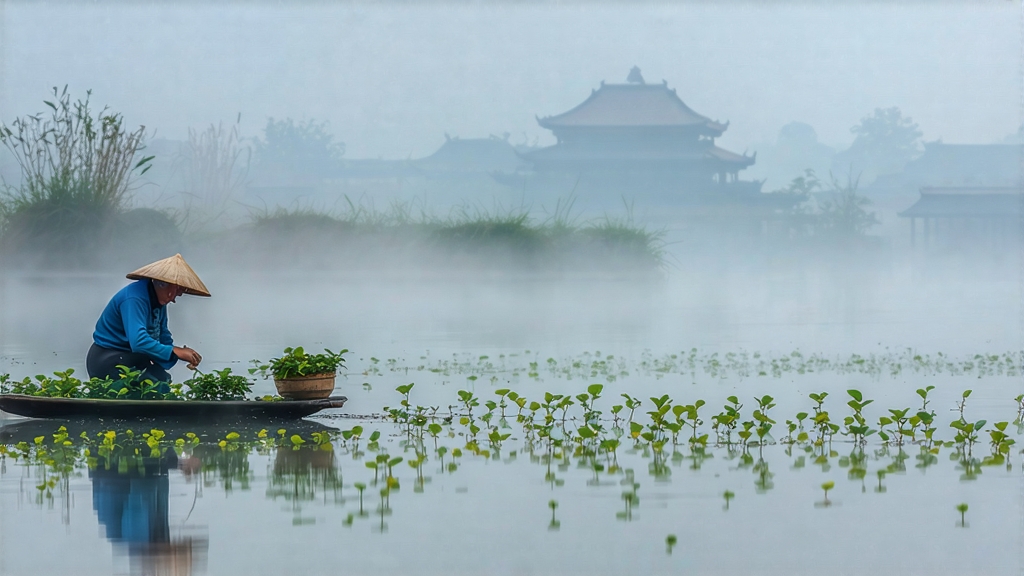
Biluochun, whose name literally means “Green Snail Spring,” is one of China’s ten most celebrated teas, yet it remains a quiet legend outside specialist circles. Grown on the mist-lapped islands and peninsulas of East China’s Taihu Lake, the tea is so delicate that one kilogram contains more than fourteen thousand hand-picked buds. To international drinkers accustomed to the vegetal punch of Sencha or the nutty breadth of Longjing, Biluochun offers a different grammar of green: tiny spirals that smell of peach skin and seawater, a liquor that glows like pale jade, and a finish that lingers like the echo of a temple bell across water.
Historical whispers place the tea’s birth in the late Tang dynasty, when a monk on Dongting Mountain noticed that tea bushes growing wild among peach, plum and apricot trees produced buds of unusual fragrance. Local records from the Kangxi reign (1662-1722) first coin the name “Biluochun,” reputedly bestowed by the emperor himself after tasting the tea and noting both its snail-like curl and its arrival with the spring equinox. For three centuries the leaf remained a tribute tea, carried by fast boat along the Grand Canal to Beijing, wrapped in silk and lotus leaves to preserve its perfume.
Today the appellation “Biluochun” is legally restricted to leaf picked within a 120-square-kilometer core zone around Dongting East and West Mountains in Suzhou, Jiangsu. Even within this micro-region, growers distinguish between “Mountain Original” and “Lake Fringe” gardens. Mountain Original bushes sit between 150–300 m on weathered granite soils; the roots struggle, yielding smaller buds but higher aromatics. Lake Fringe gardens, watered by morning mist rising off Taihu, give larger, greener spirals with a softer cup. Purists further separate Mingqian (pre-Qingming) tea, picked before April 5, from Yuqian (pre-Grain Rain) lots; the former is so tender that fifty thousand buds make one liang (50 g).
The crafting of Biluochun is a six-hour choreography performed on the same day the leaf is picked. First, “kill-green” (shaqing): buds are tossed into a drum pan heated to 180 °C for exactly ninety seconds, just long enough to halt oxidation while preserving the downy tips. Next, “primary rub”: the still-hot leaf is rolled between bamboo mats to break cell walls and release sap; this is when the fruity aroma first becomes unmistakable. The critical third step is “spiraling,” unique to Biluochun. Craftsmen lower the temperature to 70 °C and, with three fingers, press and twist each handful into a tight spiral against the pan. One master can finish 250 g in an hour; novices often scorch the tips or leave them half-open, losing the signature curl. Finally, the leaf is dried in two passes, 60 °C then 45 °C, reducing moisture to 5 % while locking in fragrance. When complete, a finished bud weighs only 0.05 g yet contains more than 500 identified volatile compounds, among them linalool (peach) and (Z)-3-hexenyl hexanoate (orchard breeze).
Water is the silent ingredient. Taihu itself is too hard; locals collect sweet spring water from Tiger Hill or filter municipal supply through bamboo charcoal. The classic gaiwan recipe calls for 3 g of leaf in a 120 ml vessel, water at 75 °C, and an initial five-second rinse that is discarded. The first formal infusion, ten seconds, releases a pale champagne liquor with a top note of loquat and a tail of fresh pea. Steep two, fifteen seconds, adds a creamier texture reminiscent of blanched fava bean. By the fourth infusion the leaf fully unfurls, revealing the intact “one bud with one leaf” pluck standard; the cup turns lighter but gains a marine minerality, like breathing sea air through an orchard.
Western drinkers often over-leaf, seduced by the perfume. A more forgiving method uses a 300 ml glass teapot, 2 g of leaf, 80 °C water, and three-minute steeps. The glass reveals the “dancing” of spirals as they sink, then rise, then sink again—a kinetic ballet prized in Jiangsu teahouses. Regardless of vessel, avoid boiling water; it flattens the esters and leaves a metallic edge.
Tasting Biluochun is best done in